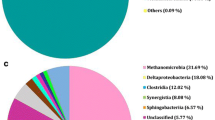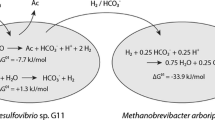Abstract
Methanogenesis from furfural by defined mixed cultures was studied. Under sulfate-reducing conditions, a Desulfovibrio strain was used as the furfural-degrading species producing acetic acid. This sulfate-reducing bacterium (SRB) Desulfovibrio strain B is an incomplete oxidizer, unable to carry out the terminal oxidation of organic substrates, leaving acetic acid as the end product. Introduction of acetate-utilizing methanogenic archaeon Methanosarcina barkeri 227 converted acetic acid to methane. This well-defined mixed consortium used furfural as its sole source of carbon and converted it to methane and CO2. In the mixed culture, when a methanogen inhibitor was used in the culture medium, furfural was converted to acetic acid by the Desulfovibrio strain B, but acetic acid did not undergo further metabolism. On the other hand, when the growth of Desulfovibrio in the consortium was suppressed with a specific SRB inhibitor, namely molybdate, furfural was not degraded. Thus, the metabolic activities of both Desulfovibrio strain B and M. barkeri 227 were essential for the complete degradation of furfural.
Similar content being viewed by others
Author information
Authors and Affiliations
Additional information
Received: 15 August 2001 / Accepted: 20 September 2001
Rights and permissions
About this article
Cite this article
Boopathy, R. Methanogenesis from Furfural by Defined Mixed Cultures. Curr Microbiol 44, 406–410 (2002). https://doi.org/10.1007/s00284-001-0010-z
Published:
Issue Date:
DOI: https://doi.org/10.1007/s00284-001-0010-z




